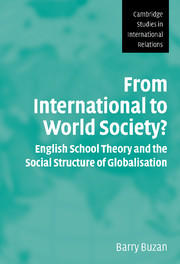 From International to World Society?
From International to World Society? Book contents
- Frontmatter
- Contents
- List of figures and tables
- Preface
- List of abbreviations
- Glossary
- Introduction
- 1 English school theory and its problems: an overview
- 2 World society in English school theory
- 3 Concepts of world society outside English school thinking
- 4 Reimagining the English school's triad
- 5 Reconstructing the pluralist–solidarist debate
- 6 The primary institutions of international society
- 7 Bringing geography back in
- 8 Conclusions: a portrait of contemporary interstate society
- List of references
- Index
- CAMBRIDGE STUDIES IN INTERNATIONAL RELATIONS
4 - Reimagining the English school's triad
Published online by Cambridge University Press: 14 January 2010
- Frontmatter
- Contents
- List of figures and tables
- Preface
- List of abbreviations
- Glossary
- Introduction
- 1 English school theory and its problems: an overview
- 2 World society in English school theory
- 3 Concepts of world society outside English school thinking
- 4 Reimagining the English school's triad
- 5 Reconstructing the pluralist–solidarist debate
- 6 The primary institutions of international society
- 7 Bringing geography back in
- 8 Conclusions: a portrait of contemporary interstate society
- List of references
- Index
- CAMBRIDGE STUDIES IN INTERNATIONAL RELATIONS
Summary
The survey in chapter 3 exposed four underlying conceptual dyads on which much of the discussion (and the confusion) about international and world society hang:
state and non-state levels, and whether or not the distinction between them is what defines the difference between international and world society;
physical (or mechanical) and social concepts of system, and whether the distinction along these lines between ‘international system’ and ‘international society’ should be retained, and/or carried over into one between ‘world system’ and ‘world society’;
society and community, and whether or not these two conceptions of social relations need to play a larger role in thinking about both international and world society, and what the implications of their doing so are for understanding pluralism and solidarism;
individuals and transnational actors as the units of analysis that define world society, and whether or not they can comfortably be considered together, or whether more analytical leverage is acquired by keeping them distinct.
The choices posed by these dyads need to be made explicit, and to be resolved in some way, before any clear sense can be made of English school theory as a social structural project. For the reasons given above, my starting position will be to reject the inclinations of the Vincentians and many of the non-English school users of world society, to construct world society in holistic terms that combine the state and non-state into a kind of higher, or better developed, social form.
- Type
- Chapter
- Information
- From International to World Society?English School Theory and the Social Structure of Globalisation, pp. 90 - 138Publisher: Cambridge University PressPrint publication year: 2004


